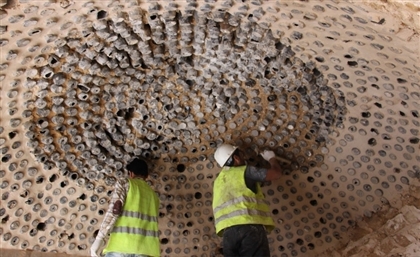Around the World With Egyptian Obelisks
We take a look at 17 ancient Egyptian pillars, and the history that led them to their current locations around the globe.
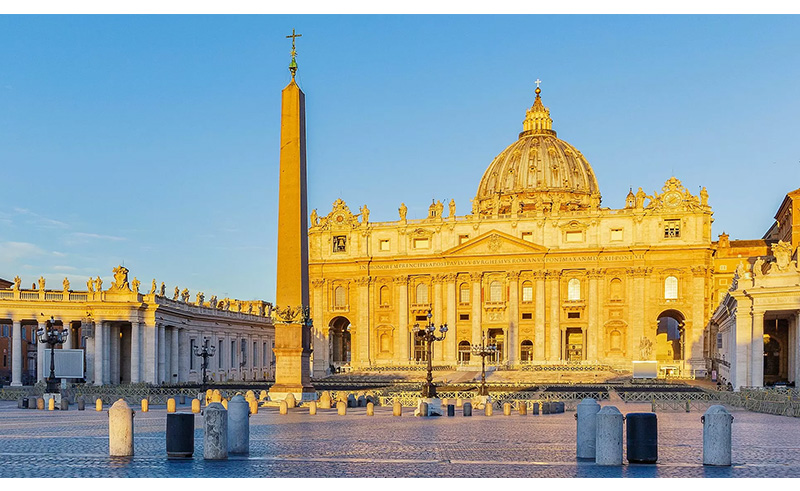
Pyramids are perhaps the most recognisable of ancient Egyptian structures. The ultimate Egyptian monoliths, however, are obelisks - the first skyscrapers, the manifestation of a king’s glory, the apex of a conquering civilisation.
Carved out of single blocks of stone in Aswan, obelisks had a myriad of meanings to ancient Egyptians, from rebirth and eternity to celebrating the sun god Ra. They were also meant to protect the kingdom, creating a connection between heaven and earth.
Whether they were moved during conquests or, in more modern times, gifted to friendly nations, more than half of the documented obelisks stand far from their original homes in Egypt. We take a look at 17 ancient pillars, and the history that led them to their current locations. Also, because size does matter (where it concerns obelisks, at least), we’ll cover these structures from tallest to shortest, without factoring in their bases.
1- Lateran Obelisk, Lateran Palace, Rome, Italy
-571ddfd7-27b8-4c50-8f9d-eda52b916611.jpg) Let’s address the elephant in the room. There are more obelisks in Italy than in Egypt. The Lateran Obelisk is the largest standing in the world with a height of 32.18m, second only to the Unfinished Obelisk which remains in its ancient quarry to this day.
Let’s address the elephant in the room. There are more obelisks in Italy than in Egypt. The Lateran Obelisk is the largest standing in the world with a height of 32.18m, second only to the Unfinished Obelisk which remains in its ancient quarry to this day.
Built during the reigns of Thutmose III and Thutmose IV, 1479-1425 BC and 1401-1391 BC respectively, it was moved to Alexandria in the early 4th century before being shipped to Rome where it found a temporary home in the Roman entertainment venue, Circus Maximus.
The obelisk, which originally stood in Karnak, collapsed and fell in the 5th century, and then was restored in the 1580s. Shortly after, Pope Sixtus V had it topped with a cross. As you will learn, that was the fate of every obelisk that made its way to Italy.
2- Vatican Obelisk, St. Peter’s Square, Vatican City
-807fd30b-3960-4c67-a45b-49e17e146072.jpg) Originally erected in Heliopolis, it was moved by Emperor Augustus to Alexandria. It was initially placed in Rome near the Circus of Nero before it found its permanent home surrounded by a plethora of Roman engravings.
Originally erected in Heliopolis, it was moved by Emperor Augustus to Alexandria. It was initially placed in Rome near the Circus of Nero before it found its permanent home surrounded by a plethora of Roman engravings.
And no, its hieroglyphs were never painted over or removed because it was one of few to never have the Egyptian language inscribed on it in the first place. It, too, got topped with a cross by the Pope as part of its christening, due to the belief that had obelisks been untopped they would’ve been worshipped by pagans.
3- Flaminio Obelisk, Piazza del Popolo, Rome, Italy
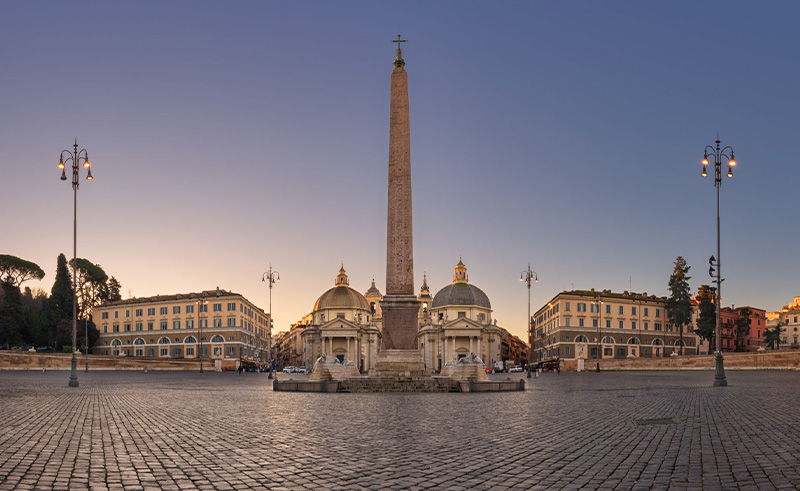 Initially built under the rule of Seti I, 1294-1279 BC, only three sides of the currently named ‘Flaminio Obelisk’ had inscriptions. Among them was the king’s vision of ‘filling Heliopolis with obelisks’. Its inscriptions were later completed during the reign of Ramses II, 1279-1213 BC.
Initially built under the rule of Seti I, 1294-1279 BC, only three sides of the currently named ‘Flaminio Obelisk’ had inscriptions. Among them was the king’s vision of ‘filling Heliopolis with obelisks’. Its inscriptions were later completed during the reign of Ramses II, 1279-1213 BC.
The 24m high pillar was moved to Rome by Augustus, along with the upcoming Montecitorio Obelisk, before it was rediscovered in multiple pieces. To gather worthy materials to rebuild the Egyptian monolith, Pope Sixtus V demolished the Septizodium, one of Rome’s most significant pieces of architecture.
4- Luxor Obelisk, Place de la Concorde, Paris, France
-4ea22d93-febd-44de-bbe6-167a6e2c6ebf.jpg) During renovations on the Luxor Temple, Ramses II, 1279-1213 BC, had two obelisks added on either side of the temple. Only one, the slightly taller, still stands in its original position while the second, 22.83m high, accompanies the Eiffel Tower in Paris.
During renovations on the Luxor Temple, Ramses II, 1279-1213 BC, had two obelisks added on either side of the temple. Only one, the slightly taller, still stands in its original position while the second, 22.83m high, accompanies the Eiffel Tower in Paris.
At the peak of Napoleon’s time in Egypt, ideas of moving it to Paris (as it made for an ‘extraordinary sight’) were circulating but never realised. It wasn’t until 1830, when Muhammed Ali Pasha, the ruler of Egypt, simply gifted the obelisks to France, to be shipped by a custom-built boat called ‘Sphinx’. In return, France sent the Cairo Citadel Clock, which currently overlooks Old Cairo.
5- Obelisk of Montecitorio, Piazza di Montecitorio, Rome, Italy
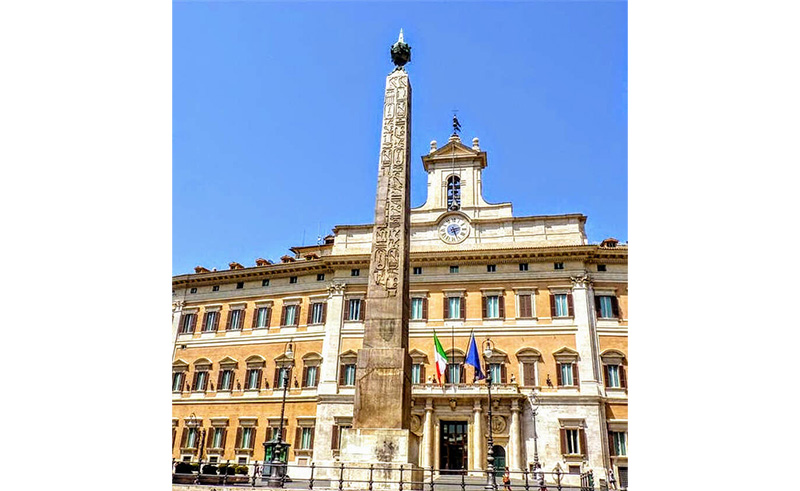 Slightly shorter, 21.79m in height, and located in a neighbouring ‘Piazza’, Montecitorio’s story is similar to that of Flaminio’s. While it currently features a variety of inscriptions, when it was first erected at the sanctuary of Ra in Heliopolis during the reign of Psamtik II, 595-589 BC, the obelisk only had hieroglyphic inscriptions.
Slightly shorter, 21.79m in height, and located in a neighbouring ‘Piazza’, Montecitorio’s story is similar to that of Flaminio’s. While it currently features a variety of inscriptions, when it was first erected at the sanctuary of Ra in Heliopolis during the reign of Psamtik II, 595-589 BC, the obelisk only had hieroglyphic inscriptions.
6- Cleopatra’s Needles, Multiple Locations
-08e15fe9-3198-4194-b386-ed0a753d4afe.jpg) After spending almost two millennia in Cleopatra VII’s Caesareum of Alexandria, ‘Cleopatra’s Needles’ now stand in London and New York City, making their move in 1878 and 1881 respectively. The relocation and re-erection of the obelisks was a sight to see for their time, drawing cross-country spectators in both cities.
After spending almost two millennia in Cleopatra VII’s Caesareum of Alexandria, ‘Cleopatra’s Needles’ now stand in London and New York City, making their move in 1878 and 1881 respectively. The relocation and re-erection of the obelisks was a sight to see for their time, drawing cross-country spectators in both cities.
Under the rule of Ismail Pasha, former Khedive of Egypt, the obelisk's travels conveniently presented themselves as solutions to public debt. The London needle was offered in 1819 but remained in place 58 years before its transport was sponsored in 1877. During the same year, the second needle was erected in Central Park.
Both needles have deteriorated due to weather conditions, something that was picked up by renowned Egyptologist and Former Minister of Antiquities, Zahi Hawass, calling for the restoration of the 21m obelisks carved during the reign of Thutmose III, 1479-1425 BC.
7- Obelisk of Theodosius, Sultanahmet Square, Istanbul, Turkey
-b2014a86-3b7b-4976-9b73-cc4ff835397e.jpg) Also built during the days of Thutmose III, and originally as tall as the Lateran, the Obelisk of Theodosius features a unique design with singular columns of hieroglyphs running along its four sides, telling the tale of the ruler’s victories in battle.
Also built during the days of Thutmose III, and originally as tall as the Lateran, the Obelisk of Theodosius features a unique design with singular columns of hieroglyphs running along its four sides, telling the tale of the ruler’s victories in battle.
While the obelisk currently stands 18.54m high in Istanbul, it took the long road to the Turkish capital. Roman emperor Constantius moved it, along with the Lateran Obelisk, to Alexandria. Unlike its travel companion, the Theodosius remained in the coastal capital until 390 AD before it made its way to the Hippodrome of Constantinople.
8- Macuteo Obelisk, Piazza della Rotondo, Rome, Italy
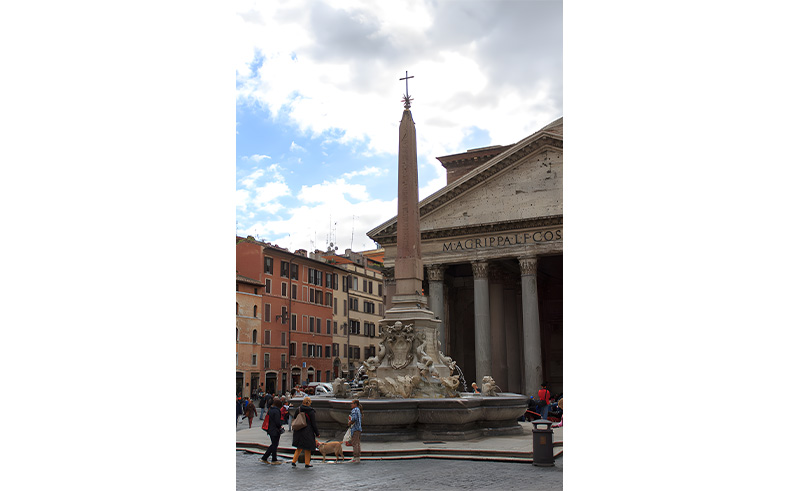 Standing in front of the gem of Roman architecture, the Pantheon, the Macuteo Obelisk was built in Heliopolis during the reign of Ramses II, 1279-1213 BC. With 14.52m of height, it complements the Pantheon’s brilliant facade with its singular monolithism.
Standing in front of the gem of Roman architecture, the Pantheon, the Macuteo Obelisk was built in Heliopolis during the reign of Ramses II, 1279-1213 BC. With 14.52m of height, it complements the Pantheon’s brilliant facade with its singular monolithism.
9- Philae Obelisk, Kingston Lacy, Dorset, United Kingdom
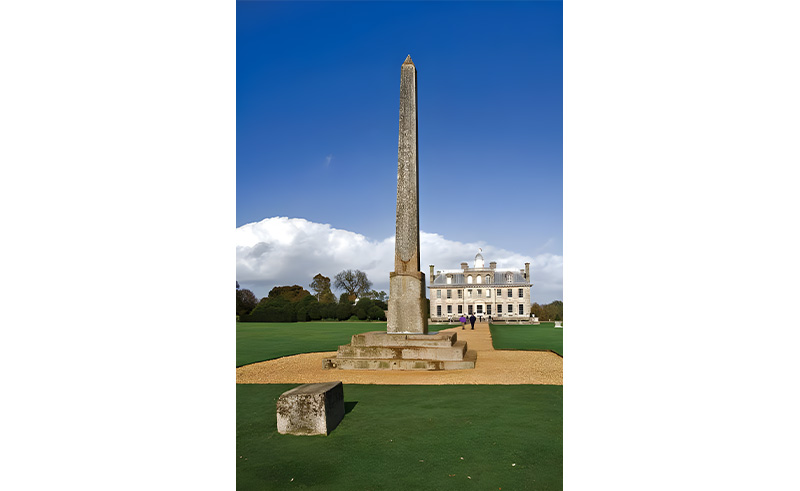 Here’s another example of separated twins. Both Philea obelisks were erected in Philea during the reign of Ptolemy IX, 116-107 BC in the Temple of Isis. English Egyptologist William John Bankes moved one of them, unsurprisingly, to his family estate in Kingston Lacy.
Here’s another example of separated twins. Both Philea obelisks were erected in Philea during the reign of Ptolemy IX, 116-107 BC in the Temple of Isis. English Egyptologist William John Bankes moved one of them, unsurprisingly, to his family estate in Kingston Lacy.
On a more noteworthy note, the hieroglyphs running along its 6.70m of height played a role in deciphering the ancient visual language. Petitions by Egyptian priests residing at Philea were inscribed along its sides, along with replies from rulers Ptolemy VIII and queens Cleopatra II and Cleopatra III.
10- Boboli Obelisk, Boboli Gardens, Florence, Italy
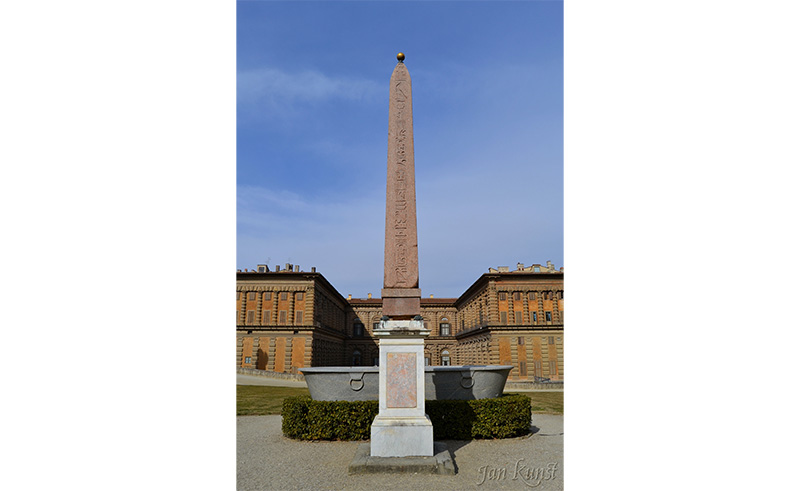 Back to the modern home of Egyptian obelisks, the 6.34m high Boboli overlooks the gardens of Florence, with hieroglyphs addressing Atum, the god of creation, and the deity of the Obelisk’s original home, Heliopolis. Built during the reign of Rameses II, the obelisk was moved multiple times including Rome by Emperor Domitian, a different location in the Italian capital by Cardinal Ferdinand I de Medici, and finally Florence when Peter Leopold became the Grand-Duke of Tuscany, where it accompanied his vast collection of artworks.
Back to the modern home of Egyptian obelisks, the 6.34m high Boboli overlooks the gardens of Florence, with hieroglyphs addressing Atum, the god of creation, and the deity of the Obelisk’s original home, Heliopolis. Built during the reign of Rameses II, the obelisk was moved multiple times including Rome by Emperor Domitian, a different location in the Italian capital by Cardinal Ferdinand I de Medici, and finally Florence when Peter Leopold became the Grand-Duke of Tuscany, where it accompanied his vast collection of artworks.
11- Poznań Obelisk, Poznan Archaeological Museum, Poznan, Poland
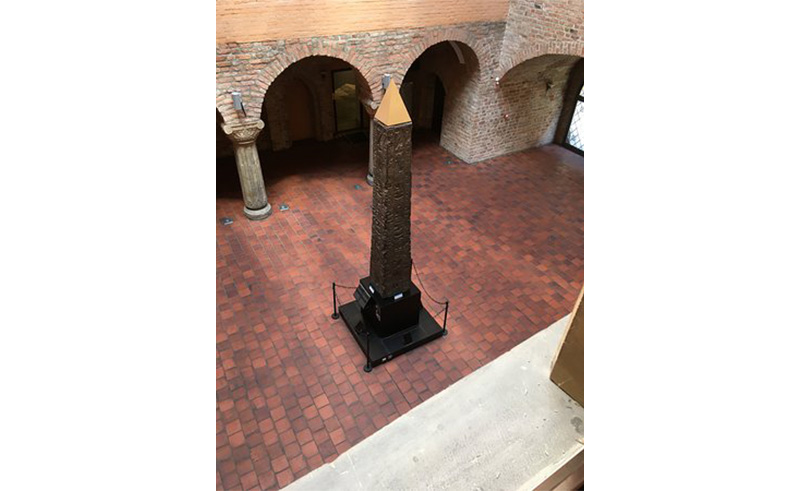 Standing 3m high in the middle of the museum’s courtyard, the Poznan obelisk is probably the most recent to make its move. A distinct feature of the obelisk is that it has three columns of hieroglyphs on each of its four sides, inscribed during the reign of Ramses II, 1279-1213 BC. It stood in Athribis, an ancient city in lower Egypt, until it was purchased and transferred to 1895, before being loaned in 2002 to the Poznan Archeological Museum.
Standing 3m high in the middle of the museum’s courtyard, the Poznan obelisk is probably the most recent to make its move. A distinct feature of the obelisk is that it has three columns of hieroglyphs on each of its four sides, inscribed during the reign of Ramses II, 1279-1213 BC. It stood in Athribis, an ancient city in lower Egypt, until it was purchased and transferred to 1895, before being loaned in 2002 to the Poznan Archeological Museum.
12- Matteiano Obelisk, Villa Celimontana, Rome, Italy
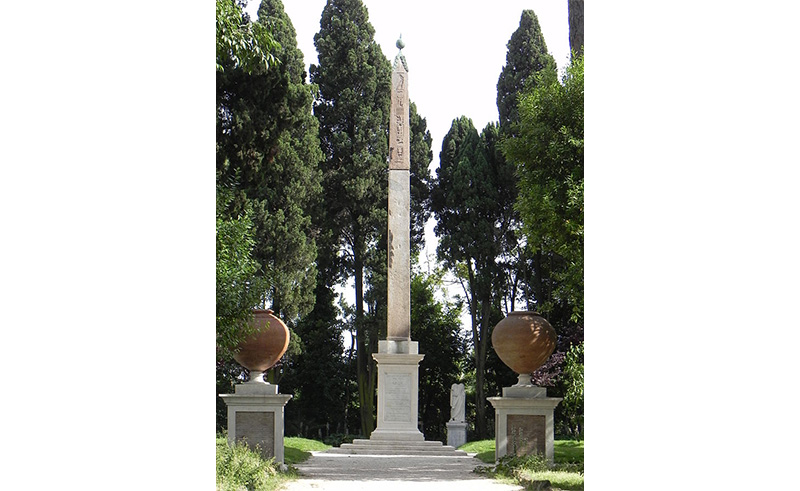 Only the uppermost parts of the Matteiano Obelisk are original - the rest has been lost to time, neglect and ill-informed senses of entitlement and ownership. Just short of three metres (2.68m), it was originally erected during the reign of Rameses II, 1279-1213 BC, in Heliopolis before it was moved to the Iseum, the Temple of Isis and eventually made its way to Rome.
Only the uppermost parts of the Matteiano Obelisk are original - the rest has been lost to time, neglect and ill-informed senses of entitlement and ownership. Just short of three metres (2.68m), it was originally erected during the reign of Rameses II, 1279-1213 BC, in Heliopolis before it was moved to the Iseum, the Temple of Isis and eventually made its way to Rome.
13- Durham Obelisk, University of Durham, Durham, United Kingdom
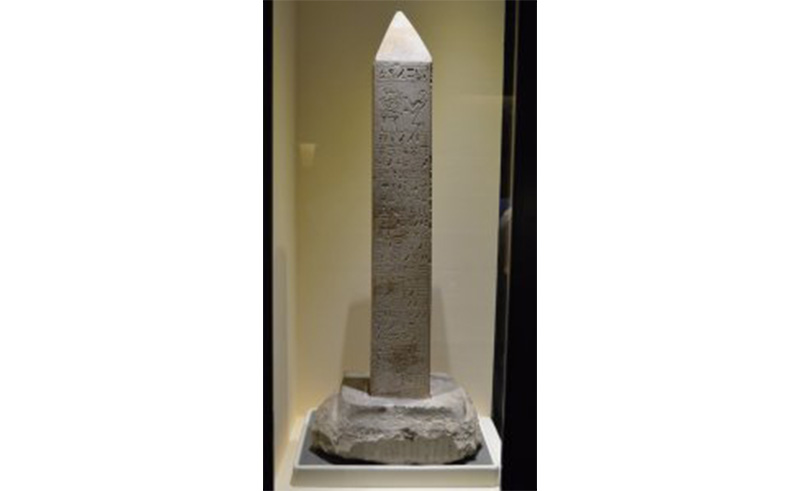 Along with the remainder of Egyptian antiquities under Duke Algernon’s collection, this Obelisk was ‘sold’ to the University of Durham. With a height of 2.15m, it features inscriptions on only one side. Carved out of Aswani quarries during the reign of Amenhotep II, 1427-1401 BC, the original home of the obelisk remains unknown - although it is understood to have been within Thebaid, the southern region of ancient Egypt, encompassing everything from Abydos to Aswan.
Along with the remainder of Egyptian antiquities under Duke Algernon’s collection, this Obelisk was ‘sold’ to the University of Durham. With a height of 2.15m, it features inscriptions on only one side. Carved out of Aswani quarries during the reign of Amenhotep II, 1427-1401 BC, the original home of the obelisk remains unknown - although it is understood to have been within Thebaid, the southern region of ancient Egypt, encompassing everything from Abydos to Aswan.
14- Dogali Obelisk, Baths of Diocletian, Rome, Italy
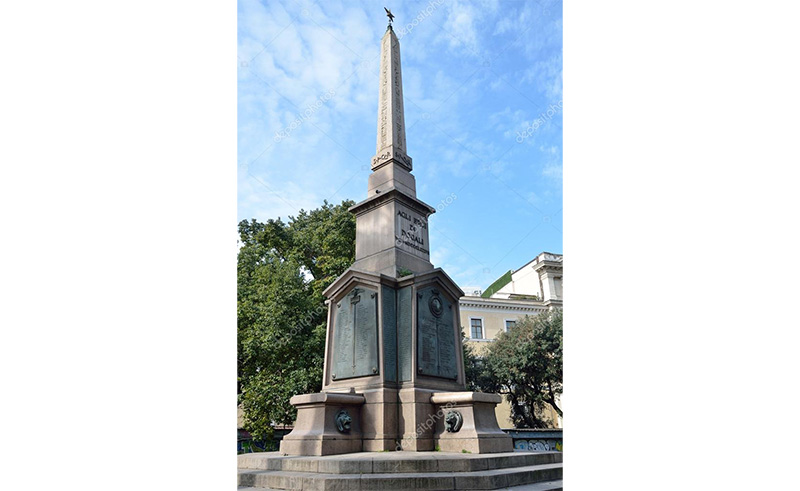 Despite its two metres of height, the Dogali Obelisk’s length is often mistaken due to its large base. While it was built during the reign of Rameses II, 1279-1213 BC, in Heliopolis, it gets its name from its modern function.
Despite its two metres of height, the Dogali Obelisk’s length is often mistaken due to its large base. While it was built during the reign of Rameses II, 1279-1213 BC, in Heliopolis, it gets its name from its modern function.
The obelisk which once protected the kingdom is now used as a public monument to commemorate the Italian soldiers lost in the Battle of Dogali, a conflict that took place during the colonial expansion in East Africa.
15- Elephant and Obelisk, Piazza della Minerva, Rome, Italy
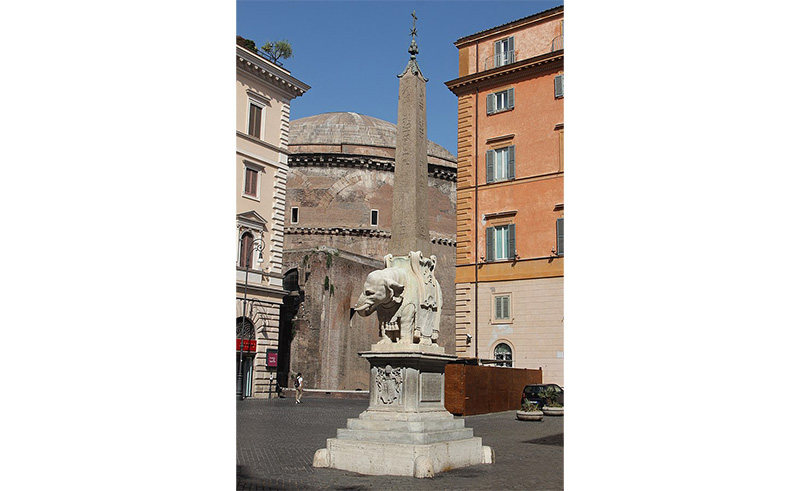 Unveiled in 1667 following its discovery under rubles near the Santa Maria church, this obelisk is perhaps the oddest. At least, considering its base.
Unveiled in 1667 following its discovery under rubles near the Santa Maria church, this obelisk is perhaps the oddest. At least, considering its base.
Originally built in Sais, the capital of Egyptian ruler Apries, 589-570 BC, this is the shortest obelisk in Rome. It’s placed on top of a sculptured elephant to fulfil a cardinal’s ‘vision’ of how it should be placed in front of his family palace.
16- Urbino Obelisk, Ducal Palace, Urbino, Italy
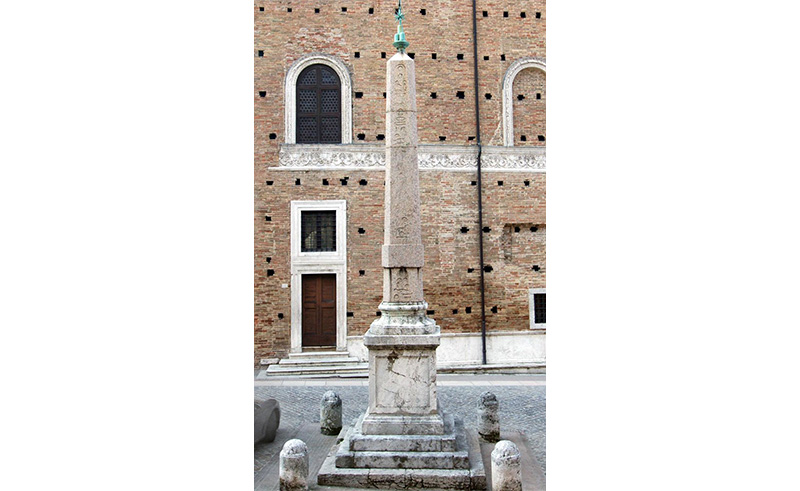 Like the obelisk currently standing over an elephant, the Urbino Obelisk also originated in Said during the reign of the same ruler as it was originally erected in the Temple of Isis.
Like the obelisk currently standing over an elephant, the Urbino Obelisk also originated in Said during the reign of the same ruler as it was originally erected in the Temple of Isis.
Its move from Rome to Urbino was done to celebrate Pope Clement XI. Now it sits in the heart of Renaissance Square with a cross sitting at its apex.
17- Obelisks of Nectanebo II, British Museum, London, United Kingdom
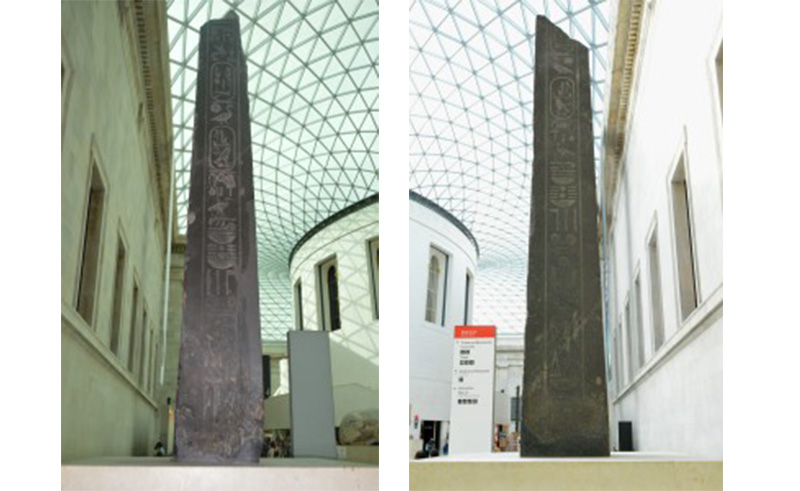 Following the chaos of Napoleon’s time in Egypt, this pair of rather short obelisks were seized by British forces. They were part of the many antiquities taken along with the Rosetta Stone. Less than a metre in height (0.95m), they can be seen on a visit to the ‘British’ Museum.
Following the chaos of Napoleon’s time in Egypt, this pair of rather short obelisks were seized by British forces. They were part of the many antiquities taken along with the Rosetta Stone. Less than a metre in height (0.95m), they can be seen on a visit to the ‘British’ Museum.
Discovered individually a couple of decades apart, the obelisks of Nectanebo II, 360-342 BC, were initially moved to Alexandria by the French, with the hopes of, of course, exhibiting them in their own flagship museum, the Louvre.
Despite their relocation by European forces, these obelisks’ original home was in the temple complex in Hermopolis. They were carved during a time known for its art renaissance, and only a fragment of their documentation is displayed in the Egyptian Museum today.
- Previous Article The Enduring Charm of Jeddah’s Old Town of Al Balad
- Next Article Coop Himmelb(L)au Crafts Iconic Design for Dubai’s Al Maktoum Airport








